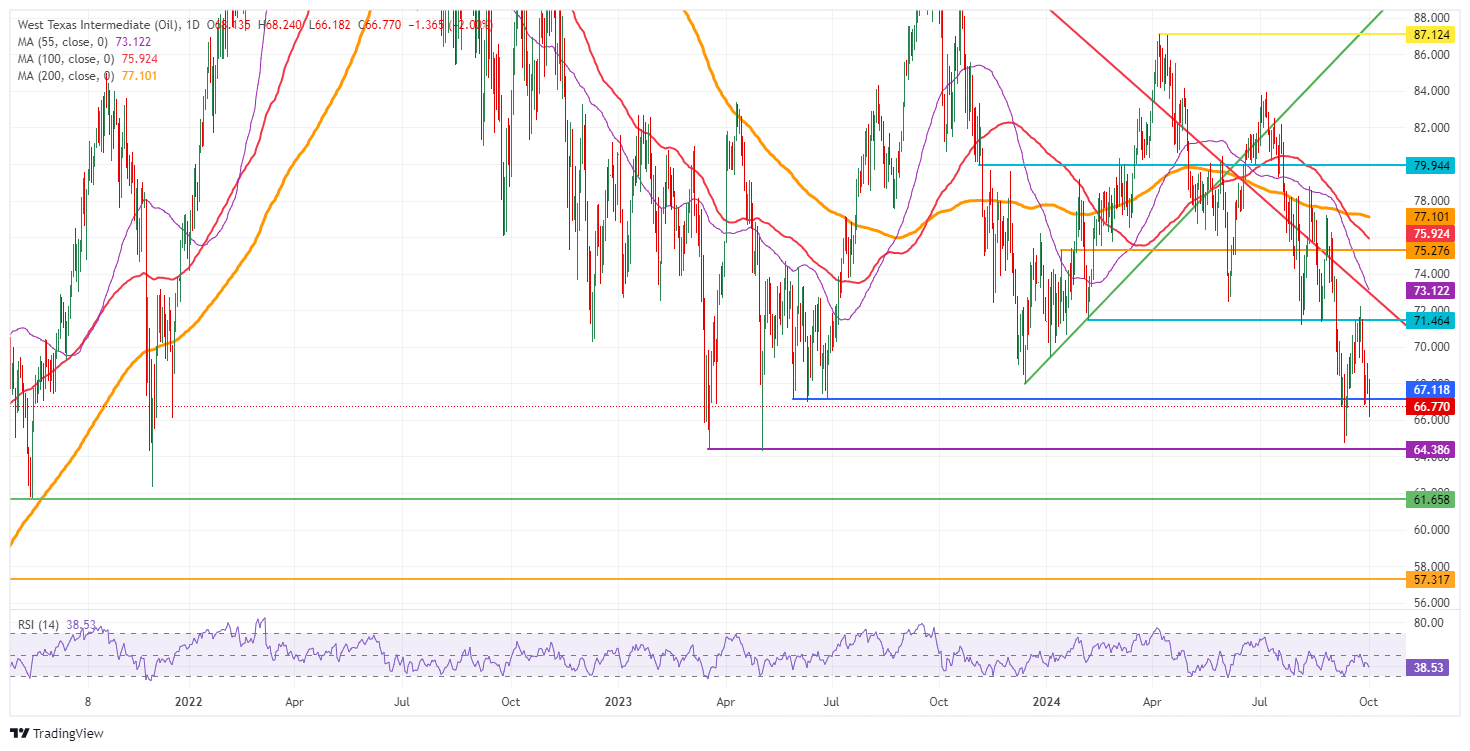- Crude oil fell more than 2% earlier as Israel violated Lebanon’s borders for a military operation.
- Traders are sending crude oil lower on anticipation of a large-scale invasion.
- US Dollar Index jumps buoyed by Fed Chair Powell’s cautious outlook on interest rate cuts and geopolitics.
Crude oil falls on Tuesday, extending Monday’s losses, even as Israel began its ground incursion into Lebanon. The operators seemed to be expecting a much larger or even large-scale ground offensive, which does not appear to be the case. Rather, the raid appears to be based on several special operations and very specific targets around border posts and villages in Lebanon, limiting the actual impact on other Middle Eastern countries.
The US Dollar Index (DXY), which tracks the greenback’s performance against six other currencies, is enjoying some inflows thanks to comments from Federal Reserve (Fed) Chairman Jerome Powell. The Fed chair rejected calls for another big rate cut in November, noting that the Fed remains dependent on data. On the agenda for Tuesday, manufacturing data from the Institute for Supply Management and JOLTS job postings for August will shed more light on the state of the U.S. economy.
At the time of writing, Crude Oil (WTI) is trading at $67.74 and Brent Crude at $71.43
Oil news and market factors: Questions arise about what happens next
- The Israel Defense Forces are attacking local villages near the border that could potentially pose an immediate threat to Israeli communities in northern Israel, Reuters reports.
- The United Arab Emirates has expressed “deep concern” over Israel’s ground operation in Lebanon, pointing out the possible repercussions of this dangerous situation for the region, Bloomberg reports.
- Hezbollah is retaliating with missiles fired deep into Israel, Reuters reports.
- On the demand side, bad news came from China with manufacturing activity slowing in September as new orders both domestically and abroad cooled, Reuters reports.
Oil technical analysis: Fasten your seatbelts
Crude oil prices are showing a textbook example here of the wisdom of “buy the rumor, sell the fact” when trading financial assets. Tensions were building towards this Israeli incursion into Lebanon in recent days. With the current event being less severe and less impactful than initially anticipated, the risk premium that had been discounted last week is now being fully discounted.
At current levels, $71.46 remains the focus after a brief false breakout last week. If a supportive catalyst remains present, a return to $75.27 (the January 12 high) could occur. On the way to that level, the 55-day SMA at $73.36 could ease the rally a bit. Once above $75.27, the first resistance to follow is $76.03, with the 100-day SMA in play.
On the downside, $67.11, a triple bottom in summer 2023, could continue to hold as support once traders who want to buy the dip push the price action above this level. If that is not the case, further down the next level is $64.38, the March-May 2023 low. Even $61.65 could come into play if a ceasefire emerges or if Israel signals that it is done with its special operation in Lebanon.
US WTI Crude Oil: Daily Chart
WTI Oil FAQs
WTI oil is a type of crude oil that is sold in international markets. WTI stands for West Texas Intermediate, one of the three main types that include Brent and Dubai crude. WTI is also known as “light” and “sweet” for its relatively low gravity and sulfur content, respectively. It is considered a high-quality oil that is easily refined. It is sourced in the United States and distributed through the Cushing facility, considered “the pipeline junction of the world.” It is a benchmark for the oil market and the price of WTI is frequently quoted in the media.
Like all assets, supply and demand are the main factors that determine the price of WTI oil. As such, global growth can be a driver of increased demand and vice versa in the case of weak global growth. Political instability, wars and sanctions can alter supply and impact prices. The decisions of OPEC, a group of large oil-producing countries, is another key price factor. The value of the US Dollar influences the price of WTI crude oil, as oil is primarily traded in US dollars, so a weaker Dollar can make oil more affordable and vice versa.
Weekly oil inventory reports published by the American Petroleum Institute (API) and the Energy Information Agency (EIA) influence the price of WTI oil. Changes in inventories reflect the fluctuation of supply and demand. If the data shows a decline in inventories, it may indicate an increase in demand, which would drive up the price of oil. An increase in inventories can reflect an increase in supply, which drives down prices. The API report is published every Tuesday and the EIA report the next day. Their results are usually similar, with a difference of 1% between them 75% of the time. EIA data is considered more reliable since it is a government agency.
OPEC (Organization of the Petroleum Exporting Countries) is a group of 13 oil-producing nations that collectively decide member countries’ production quotas at biannual meetings. Their decisions often influence WTI oil prices. When OPEC decides to reduce quotas, it can restrict supply and drive up oil prices. When OPEC increases production, the opposite effect occurs. OPEC+ is an expanded group that includes ten other non-OPEC member countries, including Russia.
Source: Fx Street
I am Joshua Winder, a senior-level journalist and editor at World Stock Market. I specialize in covering news related to the stock market and economic trends. With more than 8 years of experience in this field, I have become an expert in financial reporting.








